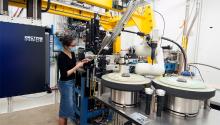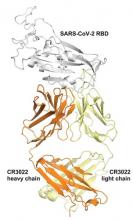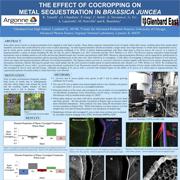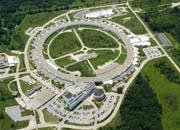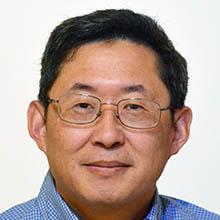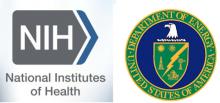2020
When the crisis represented by COVID-19 became apparent, the world’s x-ray light sources, including the user facilities funded by the U.S. Department of Energy's (DOE's) Office of Science, were quick to begin hosting essential studies of the SARS-CoV-2 virus, which causes COVID-19, in the quest to develop medical therapeutics to combat the disease. The DOE's Advanced Photon Source at Argonne National Laboratory, the groups who operate x-ray facilities there, and the researchers who use those facilities were among the first to divert experimental resources to these critical investigations.
An antibody recovered from a survivor of the SARS epidemic in the early 2000s has revealed a potential vulnerability of the new coronavirus at the root of COVID-19, according to a study carried out at the U.S. Department of Energy’s Advanced Photon Source.
Work has been ongoing at the Advanced Photon Source (APS) during minimum safe operations. APS people are on site to support continued research into the virus that causes COVID-19, keep the APS running and operational, and continue to prepare for the APS Upgrade. "Even with so few people on site, we've taken every precaution to ensure that each of our employees is able to perform their jobs safely," said APS Director Stephen Streiffer.
Critical information about the novel coronavirus, obtained by a team of University of Minnesota scientists conducting research at the U.S. Department of Energy’s Advanced Photon Source, has laid the groundwork for designing drugs to block the virus from attaching itself to, and infecting, human cells.
Glenbard East High School students have persevered through these challenging times and have completed a poster summary of their yearlong research into the effects of growing lupines with Chinese mustard. The research team began their journey last September with background research and an application to use the Advanced Photon Source at Argonne National Laboratory to evaluate where and how much metal was deposited in test plants grown at Glenbard East.
Small-angle solution x-ray scattering and biochemical characterization studies at the Bio-CAT beamline 18-ID at the APS are being used to study the structure of portions of RNA from the SARS-CoV-2 virus. This RNA contains the genetic instructions the virus uses to replicate itself.
The international network of X-ray Science Facilities is deeply engaged with overcoming the COVID-19 pandemic. The Facilities’ role is to create and implement scientific and technological research activities and contribute solutions to the pandemic, including new drugs, therapeutic strategies, and medical equipment developments. The Facilities, with the intent to further coordinate and strengthen their support of scientific research and solutions to the pandemic, assembled for a remote access video SR20 Summit on 23-24 April 2020 and adopted this Action Plan.
Getting an x-ray at the dentist or the doctor is at best a little inconvenient and at worst a little risky, as radiation exposure has been linked to an increased risk of cancer. But researchers at the Argonne Advanced Photon Source and at Los Alamos National Laboratory may have discovered a new way to generate precise x-ray images with a lower amount of exposure.

ARGONNE EXTENDS SITE RESTRICTIONS April 10, 2020
Yang Ren has been named the recipient of the 2020 “Gopal K. Shenoy Award for Excellence in Beamline Science” at the U.S. Department of Energy’s Advanced Photon Source for creating a world-leading high-energy x-ray diffraction beamline and user program for comprehensive atomic structure studies of condensed matter.

As you may have heard by now, the construction of multiple beamlines for the Advanced Photon Source Upgrade (APS-U) Project will require a staggered installation schedule, which must start significantly ahead of the dark period. This is due to the limited capacity of vendors for critical components such as enclosures, and the need to distribute the effort from local staff and contactors. That means some operating X-ray Science Division (XSD) beamlines will be going off line before the start of the dark period due to the need to move some programs to accommodate feature beamlines, while other XSD beamlines will be interrupted and re-started before APS shuts down for the installation of the new multiband achromat-based storage ring. The XSD, APS, and APS-U managements have developed a draft schedule for beamline closures and program interruptions. While the current stance of Argonne due to COVID-19 will likely affect this schedule, we would like to start communicating with the user communities as early as possible, so that they can plan for any affected research programs.

Crucial work on the APS Upgrade (APS-U) continues as an essential component of Argonne’s limited operations following Illinois Governor J.B. Pritzker’s stay-at-home order. That work is limited to necessary personnel and activities for fulfilling project milestones in the near term, including receiving and processing production magnets and power supplies. The current on-site focus is only on acceptance tests of equipment that had just arrived, or was in transit at the time of the Laboratory switching to minimum safe conditions. These activities were authorized only after ensuring work could be done with required social distancing, and safely. The overwhelming majority of the APS-U staff, like Argonne as a whole, is telecommuting for now.

To cooperate with the extension of the stay-at-home order issued March 31 by the Governor of Illinois, Argonne is extending the site restrictions enacted with the Governor’s original order to the end of April. The Lab has ceased all on-site functions except those deemed government critical and will continue to maximize telecommuting. The APS will reman operational to support critical COVID-19 related work and for critical remote research only.

At this moment, nothing we can say to you, and to your family, friends, and colleagues, is more important than this: be safe, be well. We care about you all. Right now on the Argonne web site you can read an excellent article by Jared Sagoff, of Argonne’s Communications and Public Affairs Division, entitled “Argonne’s researchers and facilities playing a key role in the fight against COVID-19.” It captures the remarkable breadth of scientific power that Argonne is marshalling against the coronavirus. This includes the Argonne Leadership Computing Facility in its role as part of the federal COVID-19 High Performance Computing Consortium, and the National Preparedness Analytics Center, “which is currently helping state emergency management agencies conduct rapid analyses around supply chain resilience in the context of pandemic planning.” By extension, the article reinforces again the unique capabilities and strengths of the Department of Energy’s national laboratory system.
Thousands of processors stacked over six feet high are networked together into the fastest computer in the world. Powerful X-rays produced by accelerating electrons to near the speed of light. Computer software that can model the complex spread of diseases. These are just some of the tools that we here at the Department of Energy are using to tackle the COVID-19 disease outbreak, widely referred to as the coronavirus.
The Advanced Photon Source Users Organization is pleased to announce
that Hsinhan (Dave) Tsai of Los Alamos National Laboratory is the recipient of
the 2020 APSUO Rosalind Franklin Young Investigator Award for his "prolific record of high
impact achievements, driving innovations in instrumental capabilities and fostering new
collaborations."
Researchers who carry out biological studies at the APS were awarded four of the seven 2020 Protein Society Awards for their lasting impact on protein science.
We regret to inform you that the 2020 APS/CNM Users Meeting scheduled for April 20-24, 2020, at Argonne National Laboratory is being canceled due to the COVID-19/coronavirus outbreak. The action to cancel the APS/CNM Users Meeting is being taken to protect the health of all meeting attendees and the well being of our entire community. We are taking this action out of an abundance of caution.
Nestor J. Zaluzec (Photon Sciences Directorate) has been named the recipient of the 2020 Peter Duncumb Award for Excellence in Microanalysis by the by the Microanalysis Society for his long-term and sustained body of work and accomplishments in advanced x-ray and electron spectroscopy of materials, including instrumentation development, methodology, software, and educational outreach to the worldwide community.
A joint National Institutes of Health-U.S. Department of Energy bioimaging working group has organized a dialog between their respective research communities. A public webinar series designed to inform the biological research community about advanced bioimaging capabilities and how to access them and describe associated data challenges has been scheduled. In parallel, the agencies are soliciting information from the research community about unaddressed research needs through a Request for Information that will be published later in March.

